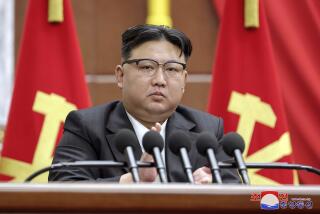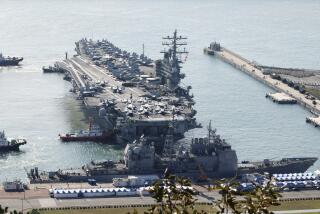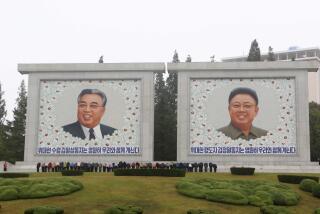Trump administration faces few good military options in North Korea

Although the Trump administration has moved an aircraft carrier strike group toward Korea and warned it would respond forcefully if Pyongyang conducts a nuclear test this weekend, likely U.S. military options range from bad to worse.
Satellite imagery has shown preparations at North Korea’s Punggye-ri nuclear weapons site, including more military personnel and mounds of dirt from recent excavations, U.S. officials and outside experts said.
North Korea’s state media has warned that Kim Jong Un’s government may use Saturday’s national holiday, marking the birthday of the country’s founder, Kim Il Sung, for a weapons test, although it could be another ballistic missile or something less provocative.
The Pentagon has moved the Carl Vinson carrier strike group to waters near the Korean peninsula as a show of force and President Trump said Wednesday that submarines were also on the prowl if necessary.
“We have submarines — very powerful, far more powerful than the aircraft carrier. That I can tell you,” Trump told Fox News.
U.S. ballistic missile submarines, known as “boomers, “ are designed specifically for stealth and the launching of conventional and nuclear warheads, according to the Navy.
For its part, the North Korean military on Friday accused the Trump administration of “maniacal military provocations” and threatened to attack U.S. bases in South Korea and other targets “within minutes” if an attack is launched on them.
“We will go to war if they choose,” vice minister Han Song Ryol said in Pyongyang.
Threats and bluster are part of a familiar and long-running game of brinksmanship between Washington and Pyongyang, but this time it has been made more dangerous by two volatile new players: Kim and Trump.
Kim, the latest member of North Korea’s ruling dynasty, is largely following the bellicose path set by his father and grandfather. He has redoubled efforts to build a nuclear arsenal but U.S. analysts don’t believe he will launch a suicidal attack that would bring about the end of his regime.
“The most unpredictable part of this story is Trump, not North Korea,” said Sue Mi Terry, a former CIA analyst who focuses on the isolated country. “North Korea is doing what it always does.”
In recent weeks, Trump has challenged U.S. foreign policy orthodoxy with headline-grabbing displays of military might and head-spinning reversals in policy.
Trump last week approved firing 59 cruise missiles at a Syrian airfield that the White House said had been used to launch a poison gas attack on a rebel-held village. It was the first intentional U.S. attack on a Syrian government site in the six-year civil war.
And on Thursday, the Air Force dropped its most powerful conventional bomb, an 11-ton behemoth, on a cave-and-tunnel complex that it said Islamic State fighters were using in eastern Afghanistan.
It was the first time the Massive Ordnance Air Blast, nicknamed the Mother of All Bombs, was detonated in combat. The huge explosion, which shook the earth for miles around, killed 36 militants, Afghan officials said Friday.
Asked Thursday if use of the massive munition was meant as a warning to North Korea, Trump gave an ambiguous answer.
“I don’t know if this sends a message. It doesn’t make any difference if it does or not,” he said. “North Korea is a problem. The problem will be taken care of.”
The problem has bedeviled the last three occupants of the Oval Office.
Diplomatic accords meant to stop or slow Pyongyang’s nuclear development all ultimately faltered, and recent tests show the country is fast closing in on the capability to build a ballistic missile that could reach U.S. territory in the Pacific or beyond.
Defense Secretary James N. Mattis twice this week sought to downplay the possibility of a U.S. attack and the significance of the carrier strike group, noting that U.S. warships regularly operate in the western Pacific.
On Thursday, however, he offered tougher talk. “The bottom line is North Korea has got to change its behavior,” Mattis said at the Pentagon.
The State Department spokesman, Mark Toner, warned of “an urgency to the situation” as well. “Provocations from North Korea have grown, frankly, too common, too dangerous to ignore anymore,” he said.
Trump called Chinese President Xi Jinping this week to enlist his support to resolve the crisis, days after the two leaders had conferred at Mar-a-Lago in Florida.
An influential Chinese newspaper, the Global Times, subsequently called for “severe restrictive measures that have never been seen before, such as restricting oil imports to the North” if Pyongyang engages in further provocative activity.
U.S. analysts say a full oil embargo could paralyze North Korea in months, but Beijing is unlikely to enforce it because of fear it would send millions flooding across its border and destabilize its Communist ally and neighbor.
Chinese foreign minister Wang Yi warned Friday of “storm clouds” gathering, saying “tit for tat threats between the United States and North Korea with daggers drawn has created a dangerous situation worthy of our vigilance.”
It’s unclear just how Trump might respond to a nuclear test.
One option that might fit his recent pattern — symbolic but dramatic — would be to reintroduce U.S. nuclear weapons to South Korea. President George H.W. Bush removed them in 1991 after the Soviet Union had collapsed, and the U.S. policy ever since has been to seek “de-nuclearization” of the Korean peninsula.
A major U.S. attack against the North could involve salvos of conventional cruise missiles from warships, attack submarines and waves of warplanes against air defense sites, missile batteries, submarine pens and other targets. It could pull in South Korean and Japanese forces plus dozens of U.S. fighter jets and heavy bombers stationed on Guam.
Under the War Powers Act, passed by Congress during the Vietnam War, presidents can order U.S. armed forces into combat without congressional approval, but only for limited periods and only in response to an attack on the U.S. or its military.
But every White House since the law was passed in 1973 has taken the position that it is an unconstitutional limit on the president’s power as commander in chief. In the most recent case, for example, Trump did not seek congressional approval before he ordered the missile strike in Syria.
A more limited military strike on Punggye-ri and other known nuclear sites could risk releasing radiation. Much of the infrastructure is supposedly buried deep underground anyway.
Cyberattacks against military command and control facilities are possible, but much of the agrarian country is off the grid. The Obama administration reportedly launched cyberattacks against North Korea’s missile program, but the impact was difficult to discern.
U.S. warships or Japanese anti-missile systems could try to destroy a North Korean missile over the ocean, while a newly installed anti-missile battery in South Korea could target one closer to its launch. But a miss could prove more of an embarrassment than a deterrent.
Diplomatic options are equally problematic. North Korea has ignored or defied numerous United Nations resolutions intended to restrain its nuclear and missile programs.
“Trump needs to make sure he does something different from [former President] Obama in response to a nuclear test. They can’t just go through the motions at the U.N. Security Council, but they have to be sure they don’t pursue a unilateral response that backfires or fails,’’ said Scott Snyder of the Council on Foreign Relations.
Given all its rhetoric, North Korea would feel hard-pressed not to retaliate against a U.S. strike.
“Our revolutionary strong army is keenly watching every move by enemy elements with our nuclear sight focused on the U.S. invasionary bases not only in South Korea and the Pacific operation theater but also in the U.S. mainland,” North Korea’s official Rodong Sinmun newspaper warned Tuesday.
U.S. analysts don’t believe North Korea can target the U.S. mainland, but 28,000 U.S. troops in South Korea and 50,000 in Japan — and tens of thousands more students, businesspeople, tourists and other Americans in those two countries — are within striking distance.
The South Korean capital of Seoul, a city of 10 million, is vulnerable to thousands of North Korean artillery pieces dug into mountains about 35 miles away, just above the demilitarized zone separating North and South Korea.
Military analysts have no doubt that combined U.S. and South Korean forces could beat North Korea. But a wounded regime could punish its adversaries — especially U.S. allies in South Korea and Japan — with what strategists sometimes refer to as the last lash of the dragon’s tail.
During the first nuclear crisis with North Korea in 1994, the Clinton administration was caught in a similar dilemma as the Pentagon drew up plans to launch cruise missiles and F-117 stealth fighters to bombard and disable a small nuclear reactor at Yongbyon.
The plan was scuttled after computer simulations showed up to 1 million people could be killed by North Korean retaliation. The casualties could be far worse today because of the expansion in Seoul’s northern suburbs and because Pyongyang possesses nuclear arms.
“The Trump administration now is relearning the same lessons that we learned in 1994,” said Carl Baker, a retired Air Force officer who was stationed in South Korea, now with the Pacific Forum CSIS think tank in Honolulu. “Trump needs to understand that all options are not on the table.”
Hennigan reported from Washington and Demick reported from New York. Times staff writer Tracy Wilkinson in Washington contributed to this report.
ALSO:
North Korea says it’s ready for war, but Pyongyang remains a city of orderly calm
Here’s what could go wrong in North Korea
Want to know what it’s like here in North Korea? Send us your questions
More to Read
Start your day right
Sign up for Essential California for news, features and recommendations from the L.A. Times and beyond in your inbox six days a week.
You may occasionally receive promotional content from the Los Angeles Times.







